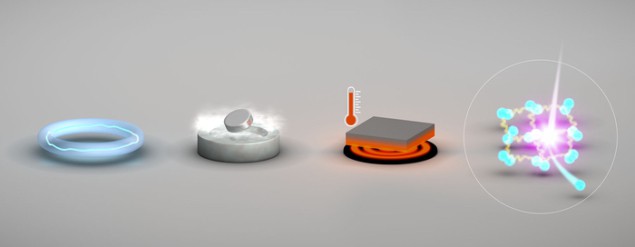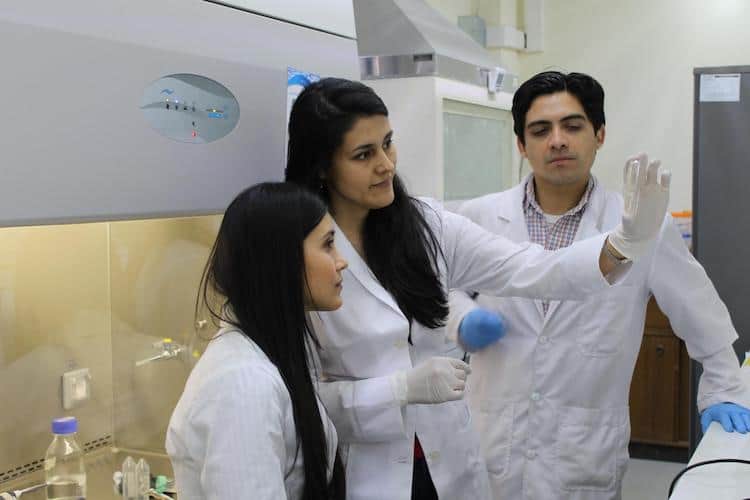Elusive superconducting-transition signature seen for the first time
04 Apr 2022 Isabelle Dumé

Researchers in the US report that they have observed the so-called “fourth signature” of superconducting phase transitions in materials known as cuprates. The result, obtained via photoemission spectroscopy of a cuprate called Bi2212, could shed fresh light on how these materials, which conduct electricity without resistance at temperatures of 77 K or higher, transition into the superconducting state.
The superconducting transition occurs when a material loses all resistance to an electrical current below a certain critical temperature Tc. At this temperature, bulk materials exhibit four characteristic “signatures” – electrical, magnetic, thermodynamic and spectroscopic – indicating that transition has occurred. The electrical signature is the development of zero resistance. The magnetic signature is the onset of the Meissner effect – that is, the material expels magnetic fields. And the thermodynamic signature is that the material’s heat capacity (the amount of heat required to increase its temperature by a given value) displays a distinctive anomaly.
According to the conventional theory of superconductivity (known as BCS theory after the initials of its authors), the fourth signature is that electrons in the material overcome their mutual repulsion and join up, forming so-called Cooper pairs that then travel unimpeded. The spectroscopic manifestation of this signature is the opening of a gap in the material’s photoemission spectrum at Tc. This gap serves as a parameter that characterizes the type of superconductivity present.
BCS theory does not, however, apply to the cuprates in a straightforward way. In these materials, which are highly doped copper oxides, electrons pair up in an unconventional “d-wave channel” rather than the usual “s-wave” one. A further quirk is that electrons in these unconventional cuprates may pair up at one temperature, only to condense at a substantially lower one. It is thus only at this second temperature that the materials actually become superconducting.
Characterizing electron behaviour
Researchers led by Zhi-Xun Shen at Stanford University and the SLAC National Accelerator Laboratory have now identified this fourth signature using high-resolution measurements made with a technique called angle-resolved photoemission spectroscopy (ARPES). In this laser- or synchrotron-based method for studying the electronic band structure of solid materials, photons with enough energy to eject electrons from a material are fired at a sample. The energy and momenta of the electrons emitted from this sample are then measured, revealing the structure of the electronic bands in terms of the energy and momentum of the electrons within them. By measuring these parameters, researchers can characterize how the electrons behave.
Shen, his then-PhD student Suidi Chen (now a postdoctoral fellow at the University of California, Berkeley) and colleagues confirmed that electrons in the cuprate material they studied, Bi2212, pair up at around 120 K. “With further decreasing temperature, we found that the ARPES signal inside the already-existing energy gap, which opens at a higher temperature near 120 K, shows the most rapid drop across 77 K,” Shen tells Physics World. This, he adds, “is exactly the superconducting transition temperature determined by magnetic susceptibility measurements on the same crystals we studied”.READ MORE

Importantly, estimates of the entropy indicated by the spectral intensity inside the gap led to a similar anomaly at Tc as the one the researchers observed in the material’s specific heat, Shen adds. This pins down the “second step” in the transition and the fourth signature of bulk superconductivity.
The methodology developed in this work, which is detailed in Science, might also be used to study phase transitions and correlation effects in other novel systems. For the moment, the researchers hope to unearth the microscopic mechanisms that determine the two temperature scales in the cuprates. “This knowledge will ultimately help us make better superconductors in the future,” Shen says.

Isabelle Dumé is a contributing editor to Physics World
from physicsworld.com 7/4/2022
Δεν υπάρχουν σχόλια:
Δημοσίευση σχολίου